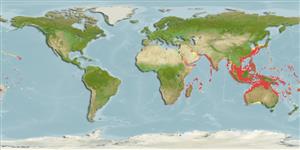>
Elopiformes (Tarpons and tenpounders) >
Elopidae (Tenpounders)
Etymology: Elops: Greek, ellops = a kind of serpent (Ref. 45335).
Environment: milieu / climate zone / depth range / distribution range
Ecologia
marino; salmastro; oceanodromo. Tropical; 38°N - 37°S, 22°E - 153°W
Indo-Pacific: Mossel Bay in South Africa, to the Red Sea and India, possibly to western Pacific (Ref. 3968).
Size / Peso / Age
Maturity: Lm ? range ? - ? cm
Max length : 118 cm FL maschio/sesso non determinato; (Ref. 40637); common length : 50.0 cm SL maschio/sesso non determinato; (Ref. 4967); peso massimo pubblicato: 10.8 kg (Ref. 40637)
Spine dorsali (totale): 0; Raggi dorsali molli (totale): 20-27; Spine anali 0; Raggi anali molli: 14 - 18.
Occurs in coastal waters, but enters lagoons and estuaries (Ref. 4832) [actual freshwater records remain to be confirmed]. Benthopelagic (Ref. 58302). Young and adults feed on small fishes and crustaceans (Ref. 5213). Probably spawn at sea, but the transparent larvae migrate to inshore areas and are often found in brackish water (Ref. 7050). Are voracious carnivores that take fish, squid and shrimp bait (Ref. 3968). Edible, but not tasty and full of bones (Ref. 3968). A total length of 126 cm for this species has been reported from Knysna, South Africa (G. Bernardt, pers. comm., e-mail: gerard@smallstreams.com) .
Life cycle and mating behavior
Maturità | Riproduzione | Deposizione | Uova | Fecundity | Larve
Smith, M.M., 1986. Elopidae. p. 155-156. In M.M. Smith and P.C. Heemstra (eds.) Smiths' sea fishes. Springer-Verlag, Berlin. (Ref. 3968)
IUCN Red List Status (Ref. 130435)
Threat to humans
Harmless
Human uses
Pesca: commerciale; Pesce da pesca sportiva: si
Strumenti
Special reports
Download XML
Fonti Internet
Estimates based on models
Preferred temperature (Ref.
123201): 20.7 - 28.4, mean 26.9 °C (based on 1366 cells).
Phylogenetic diversity index (Ref.
82804): PD
50 = 0.5176 [Uniqueness, from 0.5 = low to 2.0 = high].
Bayesian length-weight: a=0.00676 (0.00514 - 0.00889), b=2.99 (2.91 - 3.07), in cm total length, based on LWR estimates for this species (Ref.
93245).
Trophic level (Ref.
69278): 4.0 ±0.3 se; based on diet studies.
Generation time: 2.3 ( na - na) years. Estimated as median ln(3)/K based on 1
growth studies.
Resilienza (Ref.
120179): Alto, tempo minimo di raddoppiamento della popolazione meno di 15 mesi (Preliminary K or Fecundity.).
Fishing Vulnerability (Ref.
59153): Moderate vulnerability (40 of 100).
